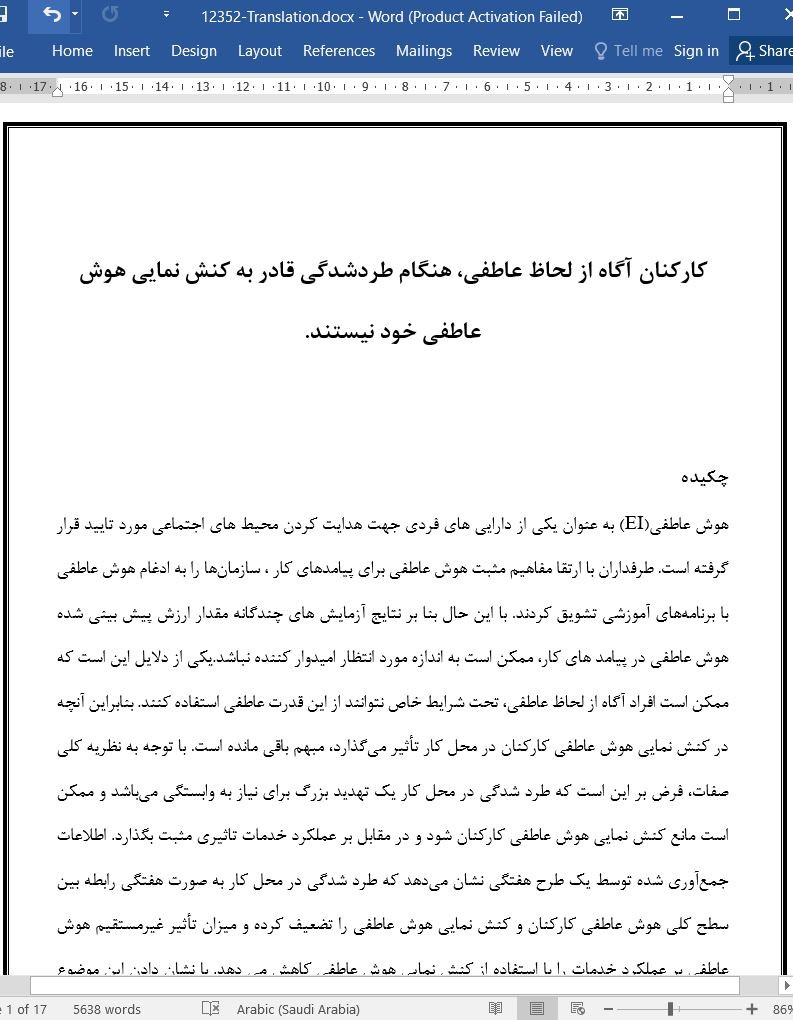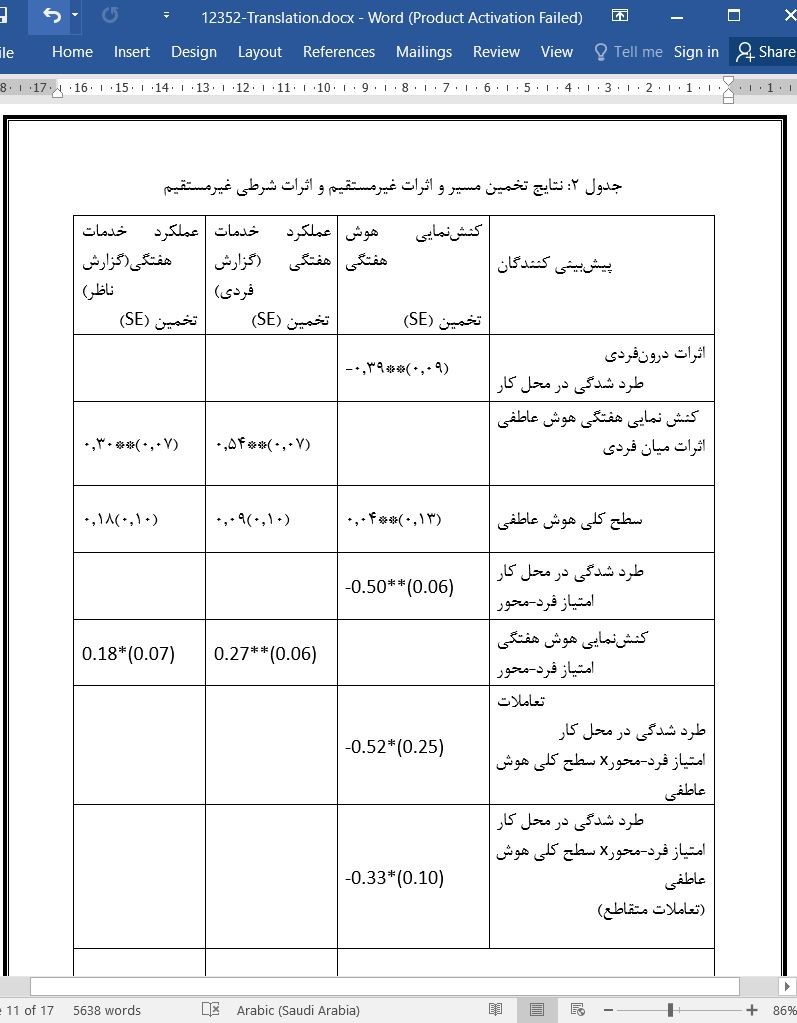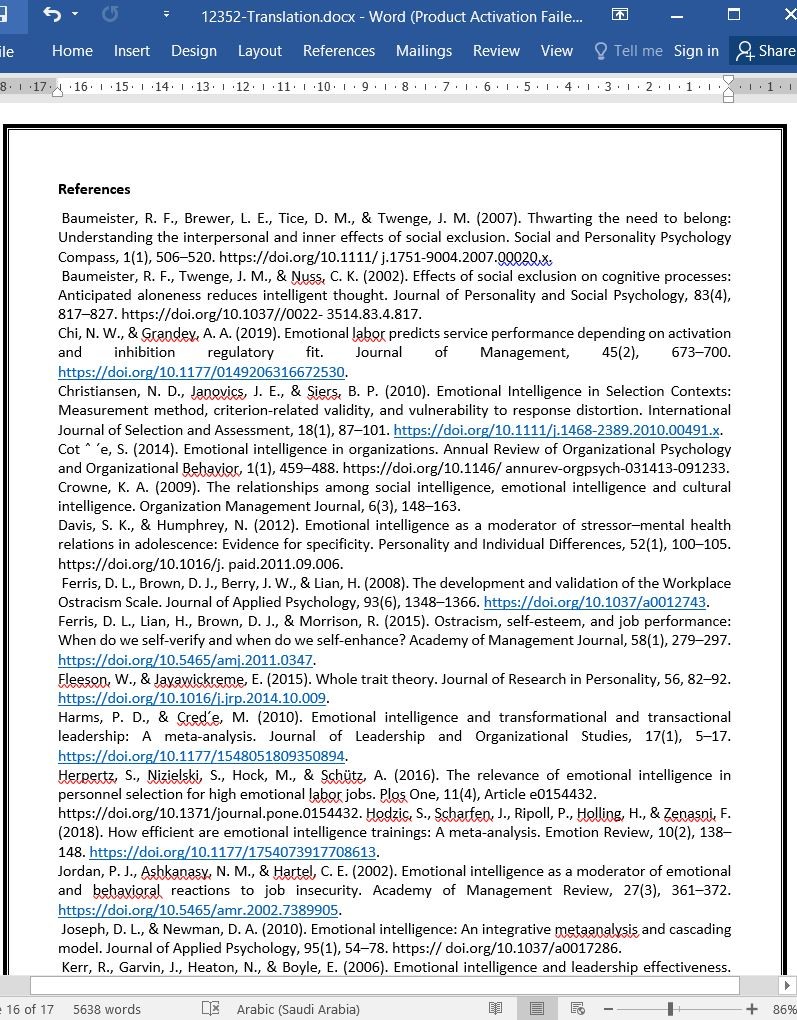
کارکنان آگاه از لحاظ عاطفی، هنگام طردشدگی قادر به کنش نمایی هوش عاطفی خود نیستند
چکیده
هوش عاطفی(EI) به عنوان یکی از دارایی های فردی جهت هدایت کردن محیط های اجتماعی مورد تایید قرار گرفته است. طرفداران با ارتقا مفاهیم مثبت هوش عاطفی برای پیامدهای کار ، سازمانها را به ادغام هوش عاطفی با برنامههای آموزشی تشویق کردند. با این حال بنا بر نتایج آزمایش های چندگانه مقدار ارزش پیش بینی شده هوش عاطفی در پیامد های کار، ممکن است به اندازه مورد انتظار امیدوار کننده نباشد.یکی از دلایل این است که ممکن است افراد آگاه از لحاظ عاطفی، تحت شرایط خاص نتوانند از این قدرت عاطفی استفاده کنند. بنابراین آنچه در کنش نمایی هوش عاطفی کارکنان در محل کار تأثیر میگذارد، مبهم باقی مانده است. با توجه به نظریه کلی صفات، فرض بر این است که طرد شدگی در محل کار یک تهدید بزرگ برای نیاز به وابستگی میباشد و ممکن است مانع کنش نمایی هوش عاطفی کارکنان شود و در مقابل بر عملکرد خدمات تاثیری مثبت بگذارد. اطلاعات جمعآوری شده توسط یک طرح هفتگی نشان میدهد که طرد شدگی در محل کار به صورت هفتگی رابطه بین سطح کلی هوش عاطفی کارکنان و کنش نمایی هوش عاطفی را تضعیف کرده و میزان تأثیر غیرمستقیم هوش عاطفی بر عملکرد خدمات را با استفاده از کنش نمایی هوش عاطفی کاهش می دهد. با نشان دادن این موضوع که طرد شدگی در محل کار هوش عاطفی را به حد و مرز خود میکشد، ما اولین تلاش را برای فاش کردن شرایط کنش نمایی کارکنان انجام دادیم و یک دیدگاه با ارزش را برای زمانی که هوش عاطفی تغییر ایجاد نمی کند، ارائه کردیم.
1.مقدمه
هوش عاطفی به عنوان ابزاری ارزشمند در نظر گرفته میشود که درک صحیحی از حالت احساسی خود و دیگران و کنش نمایی احساسی تاثیر گذار را به ما می دهد و در نهایت عملکرد اجتماعی را ارتقا می بخشد. (Mayer & Salovey, 1997) هوش عاطفی به عنوان یک کیفیت ضروری برای کارکنان دارای پستهای مدیریتی و مشاغل واسطه تایید شده است. (Kerr, Garvin, Heaton, & Boyle, 2006; Wong & Law, 2002) هوش عاطفی به قدری در تاکید بر سازگاری موثر است که از آن به عنوان یک منبع پایداری موثر برای مقابله با اتفاقات احساسی یاد میشود. (Jordan, Ashkanasy, & Hartel, 2002) بنابراین سازمانها مشتاق اند که هوش عاطفی را معیاری در انتخاب پرسنل و المان اصلی برنامههای آموزشی مدنظر قرار دهد. (Christiansen, Janovics, & Siers, 2010)(Hodzic, Scharfen, Ripoll, Holling, & Zenasni, 2018)
4. بحث و گفتگو
از آن جایی که هوش عاطفی می تواند به صورت بالقوه درک احساسات ، نظم و عملکرد اجتماعی افراد را راحت تر کند سازمانها هزینه زیادی را صرف انتخاب ابزارهای EI- محور و مداخلات آموزشی کردهاند. تحقیقات اخیر نشان می دهد که سطح بالای هوش عاطفی الزاماً به کنش نمایی موثر در محل کار منجر نمی شود. (Pekaar et al., 2018) با توجه به نظریه کلی صفات، این مطالعه هفتگی نشان داد که طرد شدگی در محل کار که تهدیدی برای تعلق اجتماعی است یک شرط محدود کننده برای رابطه میان هوش عاطفی و کنش نمایی آن است. کارکنان آگاه از لحاظ عاطفی هنگام مواجه شدن با طرد شدگی در محل کار نمی توانند به خوبی از هوش عاطفی خود استفاده کنند. تحقیق ما به اعتباربخشی به کنش نمایی درون افراد کمک میکند.
Abstract
Emotional intelligence (EI) has been endorsed as a personal asset in navigating social environments. By extoling EI's positive implications for work outcomes, advocators encouraged organizations to integrate EI into selection and training programs. Nevertheless, according to meta-analytical results, the predictive validity of EI for various work outcomes may not be so promising as expected. A possible reason is that high EI individuals may not effectively enact this emotional strength under certain circumstances. However, what influences employee EI-enactment at work remains unclear. Drawing upon whole trait theory, we posit that by workplace ostracism, a salient threat to need for belongingness, may hinder employee EI-enactment and in turn constrain EI's positive impact on service performance. Data collected with a weekly diary design demonstrated that weekly workplace ostracism weakened the relationship between employees' general level of EI and their weekly EI-enactment and reduced the indirect effect of EI on weekly service performance via EI-enactment. By showing that workplace ostracism stretches EI to its limit, we make the first attempt to uncover a boundary condition for employee EI-enactment and offers a valuable insight into when EI fails to make a difference.
1. Introduction
Emotional intelligence has been touted as a valuable asset that empowers accurate understanding of one's own and others' emotional states and effective emotional regulation, which eventually promotes social functioning (Mayer & Salovey, 1997). EI is endorsed as an indispensable quality for employees holding managerial positions (Kerr, Garvin, Heaton, & Boyle, 2006; Wong & Law, 2002) and high emotional labor jobs (Herpertz, Nizielski, Hock, & Schütz, 2016). Helpful as EI is to stress adaptation and adjustment, so that it is also deemed as a resource sustaining effective coping against emotional-laden events (Jordan, Ashkanasy, & Hartel, 2002). Thus, organizations are keen to include EI as a criterion of personnel selection (Christiansen, Janovics, & Siers, 2010) and a core element of training programs (Hodzic, Scharfen, Ripoll, Holling, & Zenasni, 2018).
4. Discussion
As EI can potentially facilitate emotional understanding, regulation and social functioning, organizations have spent much on EI-oriented selection tools and training interventions. Recent research suggests a high level of EI does not necessarily lead to effective EI-enactment at work, which in turn may hinder its potential (Pekaar et al., 2018). Drawing upon whole trait theory, this weekly diary study showed that workplace ostracism, a salient threat to social belongingness, is a reasonable boundary condition for the relationship between EI and weekly EI-enactment. High EI employees failed to enact their EI effectively during the week when experiencing a high level of workplace ostracism. Our research helps account for the substantial within-person variation in EI-enactment.
چکیده
1. مقدمه
1.1 هوش عاطفی ،کنش نمایی هوش عاطفی و طرد شدگی در محل کار
2. روش شناسی
2.1 شرکت کنندگان و مراحل
2.2 مقیاس ها
2.3 استراتژی تحلیلی
3. نتایج
4. بحث و گفتگو
منابع
ABSTRACT
1. Introduction
1.1. EI, EI-enactment, and workplace ostracism
2. Method
2.1. Participants and procedures
2.2. Measures
2.3. Analytical strategy
3. Results
4. Discussion
References
- اصل مقاله انگلیسی با فرمت ورد (word) با قابلیت ویرایش
- ترجمه فارسی مقاله با فرمت ورد (word) با قابلیت ویرایش، بدون آرم سایت ای ترجمه
- ترجمه فارسی مقاله با فرمت pdf، بدون آرم سایت ای ترجمه



